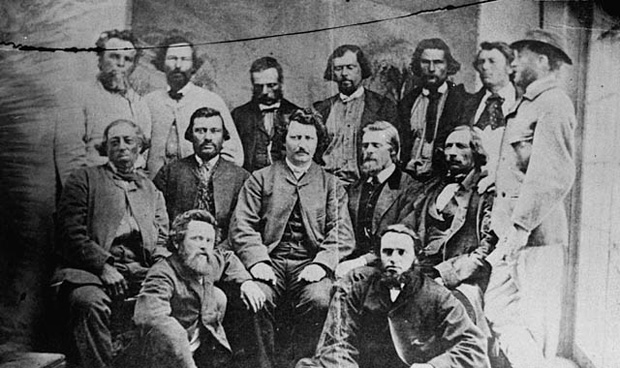This past week we have celebrated the life and death of one of Manitoba’s most famous historical figures, Métis leader and politician Louis Riel. On the surface, it might seem that the story of Louis Riel and the Red River Rebellion do not have anything to do with Mennonite history in Manitoba. On the contrary! The Red River Rebellion and Manitoba’s subsequent entry into Confederation on May 12, 1870, are actually integral to Mennonites settling in Manitoba.
The Government of Canada purchased all the land belonging to the Hudson’s Bay Company in 1869, then promptly sent out surveyors to divide this new piece of Canada into lots so it could be settled by English-speaking immigrants from the east. This worried the people who already lived in what is now Manitoba. About half of the people living here were French-speaking Catholics, many of them Métis, and they were concerned that their way of life was coming to an end. First of all, the surveyors were dividing the land into square lots instead of the long-but-narrow river lots already used in the Red River settlement. More importantly, even though people had lived and farmed there for generations, they did not have clear title to this land and were concerned that it could be taken away from them.
In response, Louis Riel prevented the surveyors and government-appointed governor from entering the settlement. He seized Fort Garry and established a Provisional Government to negotiate with the Government of Canada to represent the concerns of both the Métis and British-descended inhabitants. Delegates sent to Ottawa on behalf of the Provisional Government negotiated Manitoba’s entry into Confederation on May 15, 1870. For many years thereafter, Louis Riel’s accomplishments were overshadowed by the execution of Thomas Scott in 1870 and the 1885 Northwest Rebellion, which lead to Riel’s execution for treason. But in more recent times, he has become recognized as the founder of Manitoba.
Once Manitoba officially became a province – and once Treaty One was signed, handing over title of Indigenous lands to Canada – it was opened up for settlement. Mennonites were looking for a place where they could live freely according to their culture and religious beliefs, and the Canadian government was willing to provide that for them in Manitoba. The Mennonites were allowed to worship in their own way and live in block settlements, and they were granted freedom from conscription. Thanks to the concessions that Louis Riel negotiated, they were also allowed to teach their children in the German language.
Diaries and histories of the East Reserve contain numerous references to Mennonite/Métis encounters. A Métis man guided Mennonite delegates through the East Reserve in 1873 when the Mennonites were scouting out the land. When the first group of Mennonites landed at the junction of the Rat and Red Rivers in 1874, Métis were hired to haul Mennonites’ belongings to their village sites. Mennonite and Indigenous midwives learned skills from each other. Many Steinbach Mennonites did business with Métis in Ste. Anne and noted their excellent hospitality.
The Canadian Government was often more willing to make concessions for Mennonite settlers than for the Métis or First Nations. The boundaries of the East Reserve (current R.M. of Hanover) were moved so they didn’t infringe on the mostly-English Clearsprings Settlement, which had been established prior to 1870. However, Métis families had also claimed land in the East Reserve before it was established, but the government did not recognize their claims. It took more than 20 years to resolve this issue.
Because of their relative isolation, Mennonite communities were probably not aware of the serious tensions between Indigenous peoples and the government. They did, however, benefit directly from policies that we now recognize were harmful. It is important to also recognize this, especially as we celebrate the life of Louis Riel.




